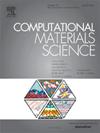O和Cl在Ti(0 0 0 1)表面的共吸附:DFT和AIMD的微观研究
IF 3.3
3区 材料科学
Q2 MATERIALS SCIENCE, MULTIDISCIPLINARY
引用次数: 0
摘要
海洋条件下氧和氯在钛表面原子尺度上的共吸附机理是至关重要的,但目前尚不清楚。本文采用密度泛函理论和从头算分子动力学方法,成功建立了富O和富Cl条件下O和Cl在Ti表面的共腐蚀模型,研究了O和Cl在预氧化Ti和NaCl包覆或沉积Ti中的动态扩散行为、吸附过程和原子键相互作用。所得吸附结果与实验观察到的现象一致。揭示了共腐蚀过程中更多的原子细节和Cl、O和Ti之间的键相互作用,促进了对活性氧化之谜的理解。发现O和Cl都倾向于在氧化物表面吸附,且Cl比O更容易扩散。Cl吸附在顶部的Ti原子上,将Ti从表面拉出形成空位,促进内部氧化。此外,O比Cl更容易渗透到内层。O通过hcp部位向内扩散,形成厚而多孔的腐蚀层,形成大量缺陷,从而提高了Cl-Ti的表面反应性。进一步提出了几种提高盐雾条件下耐蚀性的可行方法,为新型防腐金属或合金的设计提供参考。本文章由计算机程序翻译,如有差异,请以英文原文为准。

Co-adsorption of O and Cl on Ti(0 0 0 1) surface: A microscopic study by DFT and AIMD
The co-adsorption mechanism of O and Cl on Ti surface under marine condition at the atomic scale is crucial, but remains unclear. In the present work, the co-corrosion model of O and Cl on Ti surface under O-rich and Cl-rich conditions was successfully established to study the dynamical diffusion behavior, adsorption process and atomic bonding interaction of O and Cl in pre-oxidized Ti and NaCl coated or deposited Ti by using the density functional theory and ab initio molecular dynamics method. The present adsorption results are consistent with the observed experimental phenomena. More atomic details and the bonding interaction between Cl, O and Ti during the co-corrosion process are revealed to promote understanding of the puzzles about active oxidation. It is found that, both O and Cl tend to adsorb on the surface of the oxide, and Cl diffuses more easily than O. Cl can adsorb on the top Ti atom, pull Ti from the surface to form vacancy and promote the internal oxidation. In addition, O penetrates into the inner layer more easily than Cl. O can improve the Cl-Ti surface reactivity by diffusing inward through the hcp site to form a thick and porous corrosion layer with a large number of defects. Further, several feasible ways for improving the corrosion resistance under salt spray condition are recommended for the design of novel anti-corrosion metals or alloys.
求助全文
通过发布文献求助,成功后即可免费获取论文全文。
去求助
来源期刊

Computational Materials Science
工程技术-材料科学:综合
CiteScore
6.50
自引率
6.10%
发文量
665
审稿时长
26 days
期刊介绍:
The goal of Computational Materials Science is to report on results that provide new or unique insights into, or significantly expand our understanding of, the properties of materials or phenomena associated with their design, synthesis, processing, characterization, and utilization. To be relevant to the journal, the results should be applied or applicable to specific material systems that are discussed within the submission.
 求助内容:
求助内容: 应助结果提醒方式:
应助结果提醒方式:


